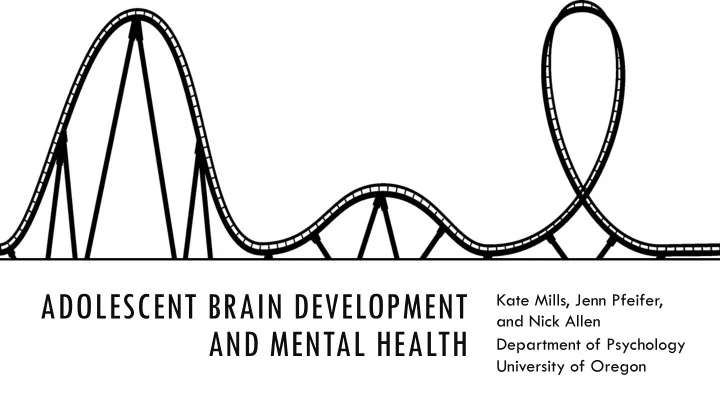

ADOLESCENT BRAIN DEVELOPMENT Kate Mills, Jenn Pfeifer, and Nick Allen AND MENTAL HEALTH Department of Psychology University of Oregon
Outline 1. Structural brain development and individual differences 2. Task-based fMRI and puberty-related theories of mental health 3. Relating brain development patterns to mental health outcomes
Body Development • Characterizing typical growth • Identifying atypical growth • Example: Failure to Thrive
Brain Development • Characterizing typical growth • Identifying atypical growth • Example: Schizophrenia Tamnes et al., 2017 Data from Four Labs Collaboration
Establishing replicable patterns of typical brain development Samples
Establishing replicable patterns of typical brain development Methods • Mixed-effects models in R • Best fitting model selected by AIC • Code available on Open Science Framework http://surfer.nmr.mgh.harvard.edu/
Cortical Grey Matter Volume Cortical Grey Matter 391 participants 852 scans 51% female Mills et al., 2016; Tamnes et al., 2017
Cerebral White Matter Volume Cerebral White Matter 391 participants 852 scans 51% female Mills et al., 2016; Tamnes et al., 2017 Reynolds et al., 2019
Statistical analysis: Raw vs. corrected measures Prefrontal Cortex 391 participants 852 scans 51% female Mills et al., 2016
Statistical analysis: Raw vs. corrected measures Prefrontal Cortex 391 participants • Controlling for whole brain volume reduces 852 scans magnitude of cortical volumetric development 51% female Mills et al., 2016
Regional differences in cortical development Cortical Grey Matter 388 participants 854 scans 51% female Tamnes et al., 2017
Grey matter volume is the product of cortical thickness and surface area Winkler et al., 2010
Cortical Thickness vs. Surface Area • There is less inter-individual variability in cortical thickness than in surface area Tamnes et al., 2017
Cortical Thickness vs. Surface Area • Cortical thinning is the dominant contributor to cortical volume reductions during adolescence Tamnes et al., 2017
Cortical thickness decreases across adolescence Tamnes et al., 2017 Data from Four Labs Collaboration
Inter-individual variability in cortical thickness Tamnes et al., 2017 Data from Four Labs Collaboration
Drawing inferences about brain development from cross-sectional data 60 Minutes, December 2018 Paulus et al., 2019
Variability between individuals > Variability within individuals Total Cerebral Volume Aubert-Broche et al., 2013 van Soelen et al., 2013 Lenroot et al., 2007
Individual Variability in Cortical Grey Matter Braintime (Leiden) Neurocognitive Development (Oslo) Child Psychiatry Branch (NIMH) Pittsburgh Mills et al., 2016 Data from Four Labs Collaboration
Cortical thickness correlates with subsequent change Data from Four Labs Collaboration
Cortical thickness correlates with subsequent change: Replication with LunaCog data LunaCog data on Data Dryad Montez, Calabro, & Luna 2017
Cortical thickness correlates with subsequent change Data from Four Labs Collaboration
Cortical thickness correlates with subsequent change Data from Four Labs Collaboration
Inter-individual variability in cortical thickness development Tamnes et al., 2017 Data from Four Labs Collaboration
Inter-individual variability in cortical thickness development Data from Four Labs Collaboration
Inter-individual variability in cortical thickness development Drawing inferences about an individual’s brain maturity requires longitudinal data! Data from Four Labs Collaboration
Longitudinal brain development fMRI • Inter-individual variability can be greater in fMRI than sMRI • Variability in overall size (intercept) • Variability in direction and magnitude of change (slope) Resting-state functional connectivity Braams et al., 2015 van Duijvenvoorde et al., 2019 Mills et al., in prep
General principles about connectivity • Modular segregation in structural and functional connectivity Functional Structural Bassett, Xia, and Satterthwaite, 2018
Keep in Mind • Maybe longitudinal data are not needed if baseline data provide the relevant information (and change does not) • We can only know if we test – so please do!
Thank you! Four labs replicable brain development collaboration NIH P ITTSBURGH Megan Rosa Christian Herting Meuwese Tamnes Anne-Lise Goddings L EIDEN Eveline Crone Berna Güro ğ lu O SLO Sarah-Jayne Blakemore Armin Raznahan Ron Dahl Elizabeth Sowell + Bea Luna & lab for sharing LunaCog dataset
Recommend
More recommend